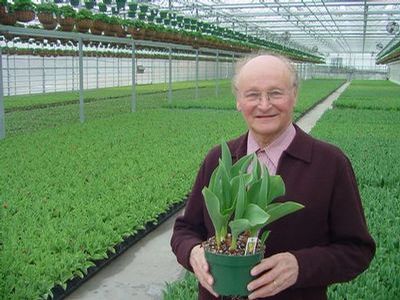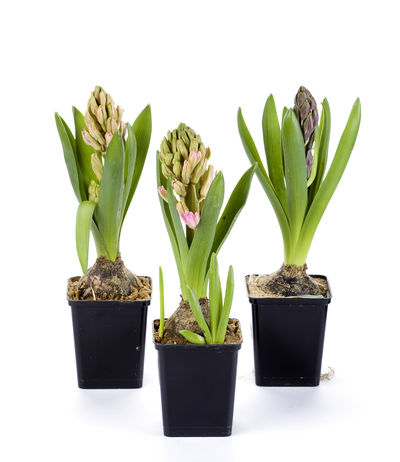Netherland Bulb Company
Known for producing Premium Holland Bulbs 1-800-78-TULIP
Easter & Mother's Day Greenhouse Production Instructions
Step 3.
Greenhouse Production
Easter & Mother's Day Greenhouse Production Instructions
Tulips
Tulip forcing time in the greenhouse depends on the temperature in the greenhouse. Some varieties like Nico Vos and Palestrina take 6 weeks at 60 degrees to force in the greenhouse. Therefore, take them out first to be forced in the greenhouse. All other varieties force around the same time. If a variety comes in too early, you can always move them to a cool area or back in the cooler at 32-34 degrees. Use the following rule of thumb for most tulip varieties:
- If the average temperature is 60 degrees both day and night tulips require 4 weeks of forcing time
- If the average temperature is 50 degrees both day and night tulips require 5 weeks of forcing time
- If the average temperature is 40 degrees both day and night tulips require 6 weeks of forcing time

Greenhouse Tips for Tulips
- Tulips like to be acclimated to the daylight, so bring your tulips in to the greenhouse at the end of the day, or on a cloudy overcast day
- Water tulips right away, and make sure during the course of forcing that when you water, water thoroughly
- Roots of the tulips are in the bottom of the pot, and that is where you need the water. The roots should never be dry
- Once a tulip is tight and is showing a little color, you can stop watering
- To avoid botrytis, do not water on cloudy days
- Water on sunny days early in the morning only
- Maintain a well-ventilated greenhouse
Hyacinths
At an average temperature both day and night of 50 to 60 degree, hyacinths require about 10 to 14 days in the greenhouse, except varieties like Marconi, Amethyst and City of Harlem; they need an additional 7 days.
Avoid a big temperature change in the beginning of the forcing period. Otherwise your hyacinths will split. To avoid hyacinths splitting we suggest you proceed as follows: (especially on early Easters)
- Slowly bring your cooler temperature up to 40 degrees for a week
- Do not water hyacinths for the first 4-5 days in the greenhouse
- If need be, cover your hyacinths with a couple of sheets of newspaper, this will enable the hyacinth and the flower inside to be drawn up
- In the beginning phase of forcing hyacinths; force at low temperatures in the greenhouse 40-45 degrees
- When the hyacinths are in the greenhouse, water normally and force just like the tulips; in a well-ventilated greenhouse
Why do hyacinths spit?
Detachment of the flower stem is caused by not enough cold weeks or vernalization, as well as, trying to force them in a warm greenhouse with roots drinking applied water.
What are enough cold weeks?
It is the number of weeks your planted bulbs in pots are in the cooler running between 36 and 48 degrees.
Note: The weeks that the potted bulbs are below 36 degrees is not considered to be part of a cold week.
Know plant date and count the number of weeks that the cooler ran between 48-36 degrees
- If you are short on the number of weeks required than raise the temperature in the cooler after you have placed the tulips in the greenhouse
- When you see that your hyacinths are reacting to the increase of the temperature inside the cooler by a lengthening sprout development, you have reached full vernalization. Use the following chart for specific hyacinth varieties:
- We have a detailed spreadsheet outlining the number of cold weeks required for each specific variety. Download below
Daffodils and Tete-a-Tete:
Like hyacinths, daffodils will force quickly in about a two week period. When growing daffodils, keep them in the greenhouse and watered. Also, just like tulip and hyacinths, once the flower is starting to show color, do not water as heavily because the roots of the plant will only drink and absorb the water, therefore the stem will only grow taller.
Download Additional Information
Optimal Cold Weeks and Days to Force
Download this attachment to find out the optimal number of cold weeks by variety as well as time to force in the greenhouse.

